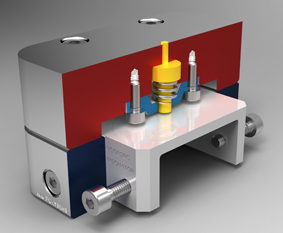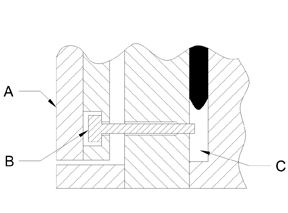Acoustic Actuator
Absatz 1
Within the project ‘PolyRegion‘ a R&D project was placed to intensive the research cooperation between the border region of Slovenia and Austria. One of the topics processed within this R&D project is the crucial topic of instrumentation of the injection moulding process, with a special focus on in-mould sensors and actuators. The research work was mainly performed by Dr. Florian Müller, researcher at the Montanuniversitaet Leoben, Austria.
 Injection moulding is a widely used process for the production of (technical) plastic parts in a mass production scale. Although current machinery is developed towards high precision and repeatability, the process is still governed by fluctuating process conditions resulting in non-stable product quality. For compensation it is an absolute must to observe the current process conditions within the mould where the part quality arises. Hence the necessity of in-mould sensor is present, whereas commonly used ones are pressure and temperature in-mould sensors. Both sensor types, however, yield the requirement of being connected via energizing and data transmitting cables which holds drawbacks in terms of mould construction as well as during runtime, i.e. space requirements for wire ducts and squeezing or ripping off of easy damageable cables.
Injection moulding is a widely used process for the production of (technical) plastic parts in a mass production scale. Although current machinery is developed towards high precision and repeatability, the process is still governed by fluctuating process conditions resulting in non-stable product quality. For compensation it is an absolute must to observe the current process conditions within the mould where the part quality arises. Hence the necessity of in-mould sensor is present, whereas commonly used ones are pressure and temperature in-mould sensors. Both sensor types, however, yield the requirement of being connected via energizing and data transmitting cables which holds drawbacks in terms of mould construction as well as during runtime, i.e. space requirements for wire ducts and squeezing or ripping off of easy damageable cables.
Absatz 2
 As a result of the drawbacks it is desirable to design sensors which do not rely on wires, and consequently are wireless in-mould sensors. Such a sensor was designed, analysed and implemented during the project ‘PolyRegion’. The novel sensor is called the ‘acoustic-emission sensor’ and is based on the transmission medium structure-borne sound. The ejector pins (B), which are an essential part of each mould, are adapted in a manner that they are movable. As soon as the melt front overflows the movable pin, it gets accelerated and impacts on a so called acoustic resonator (schematically shown as C, but also attached as additional renderings). This resonator starts oscillating with its eigen-frequency and distributes the sound within the metal mass of the mould. For identification of a major number of installed actuators different acoustic-resonators are designed. Hence, differently designed resonators oscillate with different frequencies which can be used as the separation criterion.
As a result of the drawbacks it is desirable to design sensors which do not rely on wires, and consequently are wireless in-mould sensors. Such a sensor was designed, analysed and implemented during the project ‘PolyRegion’. The novel sensor is called the ‘acoustic-emission sensor’ and is based on the transmission medium structure-borne sound. The ejector pins (B), which are an essential part of each mould, are adapted in a manner that they are movable. As soon as the melt front overflows the movable pin, it gets accelerated and impacts on a so called acoustic resonator (schematically shown as C, but also attached as additional renderings). This resonator starts oscillating with its eigen-frequency and distributes the sound within the metal mass of the mould. For identification of a major number of installed actuators different acoustic-resonators are designed. Hence, differently designed resonators oscillate with different frequencies which can be used as the separation criterion.
Using an accelerometer sensor (which acts like a microphone) it is possible to collect all the structure-borne sound from the mould. By using a sophisticated linear algebraic approach, separation and identification of the plurality of upcoming sounds is performed. Consequently, a time dependent melt front position can be sensed without implementing any wires within the mould.
To implement the acoustic-emission sensor not only in a test mold, which was specifically designed to meet the criteria of the sensor concept, a mold designed by Mahle Filtersysteme GmbH, located in Carinthia, Austria, was adapted to test the novel sensor in a more practice-oriented mold. First measurements show good functionality but still further measurements and investigations are needed to make the sensor a reliable component within an injection mold.
The topics described within this article have been presented at several conferences and have been published in peer reviewed journal (see also list at end of the article):
- PPS-28 (http://www.pps-28.com/)
- PPS-29 (http://www.pps-29.com/)
- Sensornets 2013 (http://www.sensornets.org/)
- ICPE 2013 (http://www.waset.org/)
- ICIT & MPT 2014 (www.tecos.si/icit/)
- B2B Meeting PolyRegion, Celje, Slovenia
For further queries about the acoustic-emission sensor please contact Dr. Christian Kukla (christian.kukla@unileoben.ac.at)
Absatz 3
The sensor system is patented and published in a wide sense:
Peer Reviewed:
Müller, F.; Rath, G.; Lucyshyn, T.; Kukla, C.; Burgsteiner, M.; Holzer, C.: Presentation of a Novel Sensor Based on Acoustic Emission in Injection Molding. - in: Journal of applied polymer science 127 (2013) 6, S. 4744 – 4749
Müller, F.; O'Leary, P.; Rath, G.; Kukla, C.; Harker, M.; Lucyshyn, T.; Holzer, C.: Resonant Acoustic Sensor System for the Wireless Monitoring of Injection Moulding. - in: Proceedings of the 2nd International Conference on Sensor Networks. (2013), S. 153 - 161
Müller, F.; Kukla, C.; Lucyshyn, T.; Harker, M.; Rath, G.; Holzer, C.: Wireless In-Mold Melt Front Detection for Injection Molding: A Long-Term Evaluation. - in: Journal of applied polymer science 131 (2014) 11 , S. 5628 - 5638
Proceedings:
Müller, F.; Kukla, C.; Lucyshyn, T.; Burgsteiner, M.; Holzer, C.: Wireless Melt Front Detection for Injection Moulding. - in: ICIT & MPT 2014 Conference Proceedings. (2014), S. 153 - 159
Müller, F.; Kukla, C.; Lucyshyn, T.; Holzer, C.: ACTIVATION PRESSURE INVESTIGATION FOR A PURELY MECHANICAL WIRELESS IN-MOLD SENSOR. - in: Proceedings of the Polymer Processing Society 29th Annual Meeting ~ PPS-29. (2013)
Müller, F.; Kukla, C.; Lucyshyn, T.; Holzer, C.: Performance Evaluation of Purely Mechanical Wireless In-Mould Sensor for Injection Moulding. - in: World Academy of Science Engineering and Technology (2013), S. 55 - 60. (2013 )
Müller, F.; Kukla, C.; Lucyshyn, T.; Holzer, C.: Wireless In-Mold Sensor for Injection Molding: A new Approach. - in: Proceedings of the Polymer Processing Society 28th Annual Meeting ~ PPS-28. (2012)
Non-Scientific Publications:
Müller, F.; Kukla, C.; Lucyshyn, T.; Holzer, C.: Hör auf dein Werkzeug. - in: Kunststoffe (2013) 3, S. 31 - 33